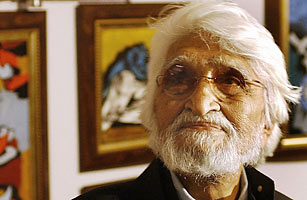
I first met M.F. Husain in New York when he was already a legend — "India's Picasso," the barefoot reinventor of Indian traditions through his prolific and iconoclastic paintbrush. We collaborated on a book about my home state of Kerala — 22 of his fine paintings together with my prose — and formed a friendship that was to last nearly two decades, till his passing at a youthful 95.
In an astonishing 60,000 paintings, sketches and murals Husain created an artistic idiom that was instantly recognizable as his — the Cubist slashes, the splashes of vivid colour, the variety of sources of Indian inspiration, especially from Hindu mythology, to whose richness and diversity he brought worldwide appreciation. His output was so prodigious that some of it is uneven. His restless creativity and desire to experiment in other fields led him to become a filmmaker, without conspicuous success, as well as to dabble in poetry and photography, architecture and even furniture-making. This was imaginative energy bubbling over, a zest for life he carried to his deathbed. It was a measure of how youthful he was in his 90s — sprightly, without stick or hearing-aid, fond of fast cars and beautiful women — that his passing came as such a shock to his friends, who had begun to think of him as immortal.
Having begun life as a painter of Bollywood cinema billboards, he was accessibly anchored to Indian popular culture, while infusing his work with energetic reimaginings of the tales and legends of Hindu tradition. Ironically for a man who depicted goddesses and the quasi-divine characters of our mythology in his work for decades, Husain's last years were blighted by lawsuits and attacks from an increasingly intolerant Hindu right over his nude paintings of Hindu divinities. Instead of applauding the decision of a Muslim artist to derive inspiration from the ancient legends of his homeland, his tormentors accused him of desecrating a faith that was not his, reducing Indianness to the narrow bigotry of their own blinkers. He fled into exile in Dubai and London.
His dying regret was his inability to return to live and work in the land whose culture suffused his art — and whose culture he has immeasurably enriched. Husain died a Qatari citizen and was buried in Britain, but his legacy was undisputably to be remembered as the greatest Indian artist of his time.
Tharoor is a member of India's Parliament and an award-winning novelist